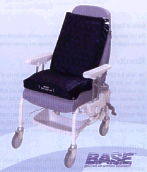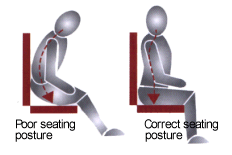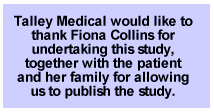|
Introduction
Sitting for long periods of time is extremely fatiguing due to the effort involved in counteracting gravitational forces and maintaining sitting stability1. As a consequence, it is inappropriate to expect ill, frail, elderly and disabled people to sit out of bed without requiring assistance with pressure relief and posture.
Interface pressures are high in the seated person due to the lack of surface area supported by the seat. Higher interface pressures are associated with a higher incidence of pressure ulcers2, and people with a low body mass index are at increased risk of pressure ulcer development3.
This case study outlines the management of one nursing home resident who had been unable to sit out of bed due to poor sitting stability and broken skin on her sacrum.
Case Study
 Mrs. Green is an eighty one year old lady who suffers from Alzheimers disease. Her condition has deteriorated to the extent that she finds it difficult to communicate and becomes easily agitated. Mrs. Green is an eighty one year old lady who suffers from Alzheimers disease. Her condition has deteriorated to the extent that she finds it difficult to communicate and becomes easily agitated.
Until the provision of the Talley B.A.S.E.™ RECLINER MAT™, Mrs. Green had been forced to remain in bed due to the development of grade 2 pressure ulcer on her sacrum. Her Waterlow score4 was 23 and she was nursed on a standard Kings Fund hospital bed with a deep cell alternating mattress.
Mrs. Green’s diet is poor and she requires the care staff to feed her. Her fluid intake is also poor. She requires hoisting in order to transfer; however, her agitation results in her being unsafe in the hoist sling and as a consequence, her manual handling risk assessment determined that she should be transferred using two staff.
Seating Assessment
 Mrs. Green had poor sitting balance and was only able to sit in a “bucket chair.” She was clearly uncomfortable in the chair for a number of reasons. Mrs. Green’s posture had fixe changes; her pelvis had rotated posteriorly and, as a result, excessive weight was taken on the sacrum, hence the pressure damage. her spine showed evidence of compensatory changes due to the position of the pelvis: the spinal column had become kyphosed and the spinous processes had become prominent close to the skin surface, causing concern regarding potential pressure damage, as the skin was starting to become reddened. Mrs. Green was unable to reposition herself in the chair and staff reported that she was constantly agitated due to her discomfort, hence the decision to keep her in bed until a suitable solution could be found. Mrs. Green had poor sitting balance and was only able to sit in a “bucket chair.” She was clearly uncomfortable in the chair for a number of reasons. Mrs. Green’s posture had fixe changes; her pelvis had rotated posteriorly and, as a result, excessive weight was taken on the sacrum, hence the pressure damage. her spine showed evidence of compensatory changes due to the position of the pelvis: the spinal column had become kyphosed and the spinous processes had become prominent close to the skin surface, causing concern regarding potential pressure damage, as the skin was starting to become reddened. Mrs. Green was unable to reposition herself in the chair and staff reported that she was constantly agitated due to her discomfort, hence the decision to keep her in bed until a suitable solution could be found.
Goals of Equipment Provision
The two main goals of equipment provision were to provide adequate postural support and pressure relief. This aimed to increase Mrs. Green’s comfort, reduce the existing pressure damage and prevent further pressure damage both on the sacrum and the spine.
Results
The Talley B.A.S.E.™ RECLINER MAT™ was secured in position on top of the seat and back surface of the bucket chair. Mrs. Green was able to sit out of bed for short periods of time, particularly at mealtimes and staff reported how much easier she was to feed in this position. Her sitting balance was more stable and staff reported an improvement in her posture. The pressure damage on her sacrum healed during the period of the evaluation and continues to remain free of damage. The skin covering the spine also looked healthier, with no further evidence of redness. The staff reported two other unexpected benefits of enabling Mrs. Green to sit out of bed. Firstly, she became far more alert, taking some interest in her surroundings and secondly, she became far less agitated. Staff felt that her reduction in agitation was directly linked to her increase in comfort and sitting stability.
Conclusion
 This case study demonstrates the positive benefits that can be achieved by providing a person with appropriate seating equipment to meet his/her specific needs and how the Talley B.A.S.E.™ RECLINER MAT™ was able to reduce pressure damage, whilst increasing posture and comfort. By enabling Mrs. Green to start getting out of bed again her feeding improved and her agitation diminished. This case study demonstrates the positive benefits that can be achieved by providing a person with appropriate seating equipment to meet his/her specific needs and how the Talley B.A.S.E.™ RECLINER MAT™ was able to reduce pressure damage, whilst increasing posture and comfort. By enabling Mrs. Green to start getting out of bed again her feeding improved and her agitation diminished.
References
1 Collins, F. (2001) Seating. Wound Care Society Educational Booklet. Vol. 8 No. 1 March
2 Geyer MJ, Brienza DM, Karg. P, Trefler E, Kelsey S (2001) A randomized controlled trial to evaluate pressure reducing seat cushions for elderly wheelchair users. Adv Skin Wound Care 14(3):120-9
3 Kernozek, TW, Wilder PA, Amundson A, Hummer J, (2002) The effects of body mass index on peak seat-interface pressure of institutionalized elderly. Arch Phys Med Rehabil 83(6): 868-71
4 Waterlow, J. (1985) A Risk Assessment Card, Nursing Times, 81: 49-55
|